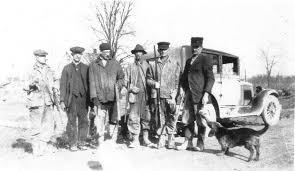
He came along with a shotgun on his shoulder while a group of children were
playing in front of the school. Without warning or provocation, he raised the
gun to his shoulder, took deliberate aim, and fired into the crowd of boys.
Although it sounds sadly modern, the account was published in the New York
Times more than a century ago.
Dated April 10, 1891, the article described an elderly man firing a shotgun
at children playing in front of St. Mary's Parochial School in Newburgh, NY.
"None of the children were killed, but several were well filled with lead,"
the report said.
More than a century earlier, on July 26, 1764, a teacher and 10 students were
shot dead by four Lenape American Indians in Greencastle, Pennsylvania, in what
is considered the earliest known U.S. mass school shooting.
Indeed, killing or trying to kill a mass of people is not a modern
phenomenon. For as long as there has been history, there have been gruesome mass
murders.
"The terms amok, a Malayan word, and berserk, a Norse word, have been used to
describe individuals going on killing sprees. Both terms have been around for
centuries, which reflects the fact that mass murder is neither a modern nor a
uniquely American phenomenon," Grant Duwe,director of research at the Minnesota
Department of Corrections, told Discovery News.
Defined as bloody events that occur within a 24-hour period and that involve
a minimum of four victims, mass murders have occurred all over the world, in
different times, societies and cultures.
Some of the earliest recorded cases include the 1893 killing with guns and
swords of 11 people (including an infant) in Osaka, Japan, the 1914 shooting of
7 people in the Italian village of Camerata Cornello, not to mention the case of
German spree killer Ernst August Wagner.
In 1913, he stabbed to death his wife and four children in Degerloch, near
Stuttgart, then drove to Mühlhausen an der Enz where he opened fire on 20
people, killing at least nine, leaving two animals dead and several buildings
burned to the ground.
In 1927, South African farmer Stephanus Swart shot dead at least 8 people and
injured 3 others in Charlestown, South Africa, before committing suicide.
In 1938 almost half of the population of the rural village of Kaio, near
Tsuyama city in Japan, was murdered as 21-year-old Mutsuo Toi killed 30 people
with a shotgun, sword and axe, injured three others and then shot himself to
death.
Between 1954 and 1957, William Unek murdered a total of 57 people in two
separate spree killings in the Belgian Congo.
He first killed 21 people with an axe, then shot dead ten men, eight women
and eight children, slaughtered six more men with the axe, burned two women and
a child, and strangled a 15-year-old girl.
More recently in the bloody timeline of shooting sprees, some of the most
dramatic incidents include the 1987 Hungerford massacre in England, where gun
enthusiast Michael Ryan shot 16 people dead and wounded another 15 before
committing suicide, the 1996 Port Arthur massacre in Australia, where 28 year
old Martin Bryant killed 35 people and wounded 21 before being caught by police,
and the 1996 school shooting in the Scottish town of Dunblane.
There, failed shopkeeper Thomas Hamilton opened fire at a primary school,
killing 16 children and a teacher before turning his gun on his mouth.
"I could have been one of those children," tennis player Andy Murray wrote in
his autobiography, "Hitting Back."
Britain's highest ranked player, Murray was eight when Hamilton burst into
the school and began shooting. He and his 10-year-old brother Jamie escaped the
fire by hiding under a desk.
In the United States, two mass murder waves characterized the 20th century.
One appeared in the 1920s and 30s and another in the mid-1960s, following a
tranquil period in the 1940s and 50s.
The two waves, however, were qualitatively different, according to Duwe.
The author of "Mass Murder in the United States: A History," Duwe researched
909 cases of mass killing that occurred in the United States between 1900 and
1999.
"The first mass murder wave in the 1920s and 30s was comprised mainly of
familicides and felony-related massacres, which, then as now, are less likely to
garner extensive media coverage," Duwe said.
On the contrary, the second mass murder wave from the mid-1960s through the
mid-1990s consisted of a greater number of mass public shootings, similar to the
recent Aurora movie theater shooting and Newtown school shooting.
These incidents "have always captured a great deal of interest and concern,"
Duwe said.
Marked by the 1966 Texas Tower shootings where student Charles Whitman
climbed a 27-story tower on the University of Texas campus shooting dead 14
people and wounding 31 others, the mid-1960s do not actually represent the
beginning of an unprecedented mass murder wave in the United States.
"Since 1900, the highest mass murder rate was in 1929. Mass public shootings
are one of several types of mass murder and generally account for roughly 10-15
percent of all mass killings in the U.S.," Duwe said.
According to the criminologists, the 1990s had the highest number of mass
public shootings with a little more than 40 -- an average of a little more than
4 each year.
The number of mass public shootings dropped below 30 in the years between
2000 and 2009.
"This year, however, the U.S. has had at least seven mass public shootings,
which is the highest number since 1999," Duwe said.
Hat Tip: Discovery News